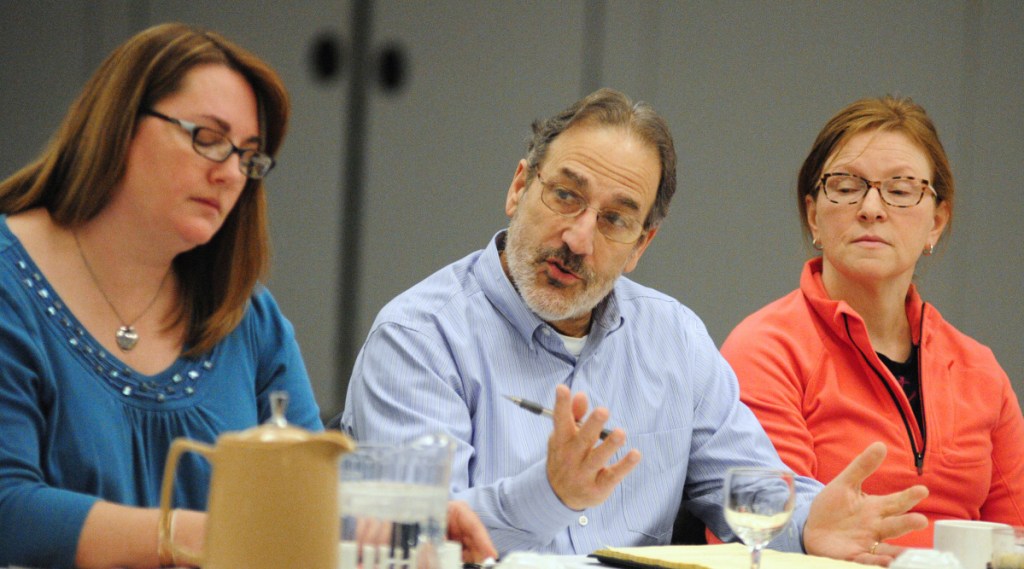AUGUSTA — A proposed $30.8 million school budget, up by about 6 percent over the current year, would require about $1.1 million more from local taxpayers.
School administrators, who have worked since at least October to put together the spending proposal, said the budget would initiate their new three-year goal of decreasing class sizes in elementary schools. Superintendent James Anastasio said that in some cases, there are as many as 26 students in a class.
“Right now class sizes in primary grades can be 25, 26, 22 … and occasionally a little bit higher than that,” Anastasio told school board members in a budget presentation Monday. “All (those class sizes) are unacceptable, but that’s because, over time, we’ve reduced the number of our teachers in the district. So we want to begin reversing that process.”
The plan to reduce class sizes includes hiring three new kindergarten teachers — one each for Farrington, Gilbert and Lincoln elementary schools. Anastasio said they would have recommended adding another kindergarten teacher at Hussey Elementary, too, but that school doesn’t have room to add a class.
Anastasio said administrators’ goals in crafting the budget also included maintaining existing positions and resources at all schools; continuing efforts to distribute resources equally among the city’s four elementary schools; adding a mathematics and science position at Cony High School; adding an elementary resource room teacher for special education; adding two elementary school social workers, one for schools on each side of the river; getting new computers for students in grades five through eight, and new laptops for grades seven to 12 teachers and Capital Area Technical Center teachers; and air-conditioning the second floors of Farrington, Lincoln and Gilbert schools.
Chris Clarke, Ward 2 board member, said he’d grown up in a school system with no air conditioning and “I’m wondering why, now all of a sudden, the push (to put in air conditioning) in the school system?”
Anastasio said while he didn’t want to talk about global warming, it seems there are longer periods of time, in the fall and spring, when the temperature in school buildings is much higher than it used to be. He said current buildings maximize heat retention in an effort to be efficient and “we’ve had a number of situations where our teachers, and students, were in trouble because of heat.”
The budget is subject to approval by the school board, which typically votes by the end of March. Then it goes to the Augusta City Council to be considered and approved as part of the overall school and city budget. Ultimately, the budget goes to voters in a referendum that usually takes place in June.
The budget would require $13.7 million, or about $1.1 million more, from local taxpayers, and 8.6 percent increase.
The state school funding formula’s “local required match” is estimated at $13.04 million, which Augusta would be expected to pay in order to get the estimated $12.5 million in state funding Augusta is expected to receive for education next year.
Anastasio noted that in recent years, Augusta has not paid the full local required match, but it didn’t suffer significant penalties from the state. He said state officials have said the coming year will be a “hardball year,” and if Augusta doesn’t provide the full local match, its state subsidy could be reduced as punishment.
Anastasio said few communities in Maine choose not to fund the required local match figure fully as determined by the state formula.
The budget would use $2.1 million in money left in the school’s unassigned fund balance, an account made up of money unspent in previous years, which Kathy Casparius, business director, said is the entire amount left in that account. She said some money is likely to come back into that account once final expenses are determined, but that school officials were trying to keep that account balance at less than 3 percent of the total budget.
Money for teacher salaries is up about $1.12 million in the budget.
Funding is included in the budget to purchase a new English language arts curriculum, with $72,000 for kindergarten to grade two and $47,000 for grades three to six.
Donna Madore, assistant superintendent, said the district’s current English curriculum was purchased in 2005, before the state’s Common Core standards were in effect.
“It’s going to take a while to digest,” Chairman Ed Hastings said of the budget proposal. “At some point we’re going to have to sit down and discuss the bottom line. And it is a big bottom line.”
Keith Edwards — 621-5647
Send questions/comments to the editors.



